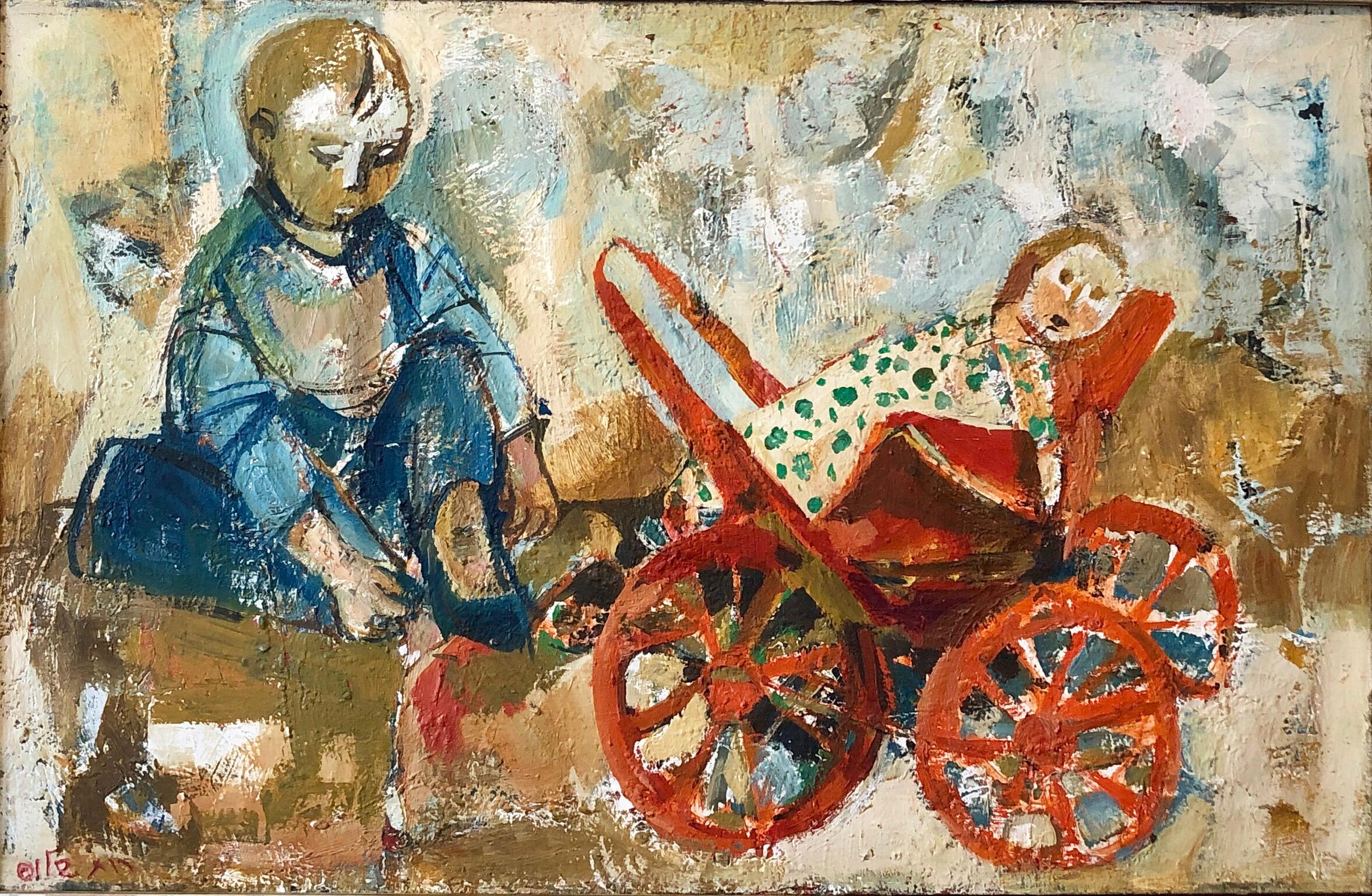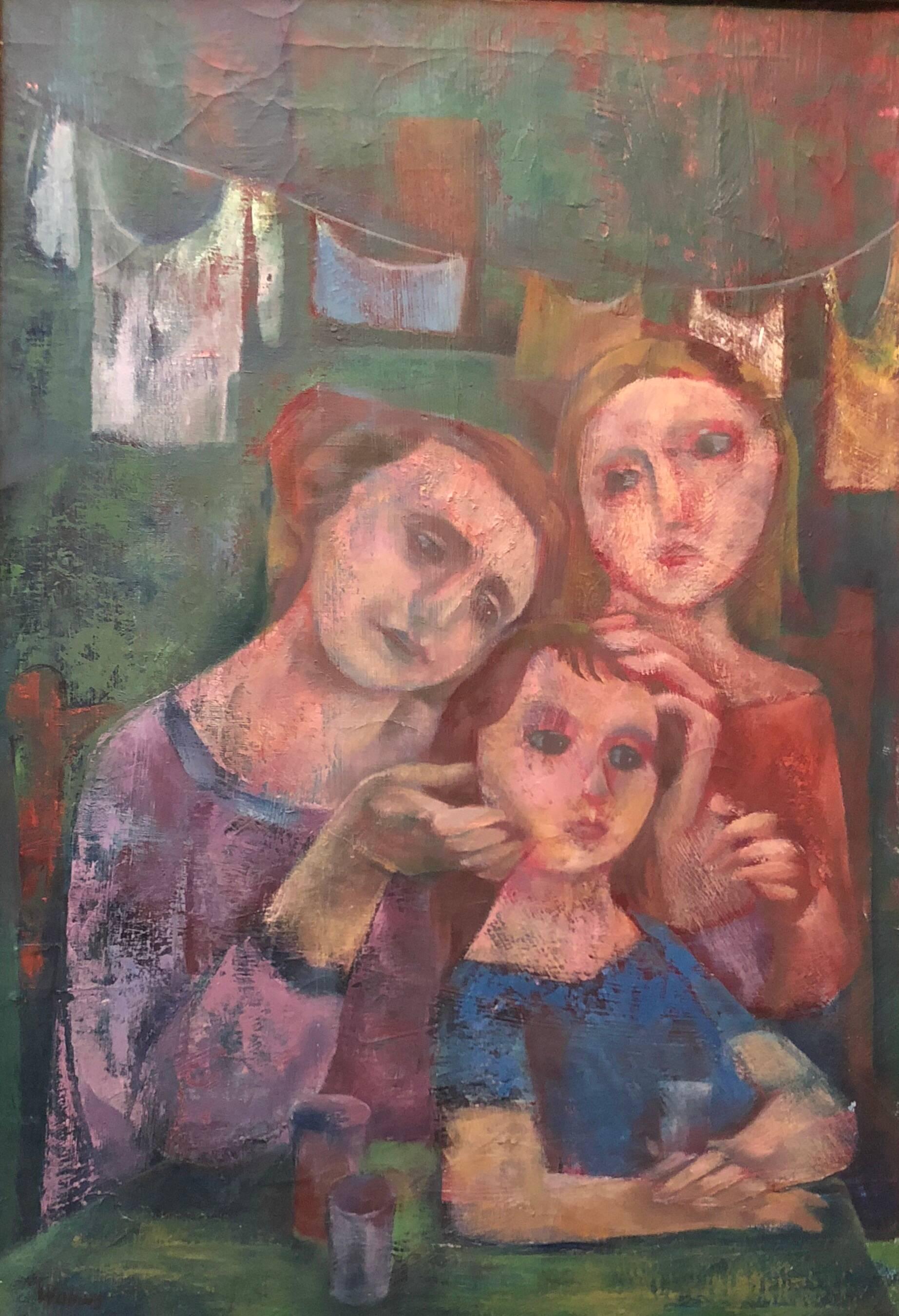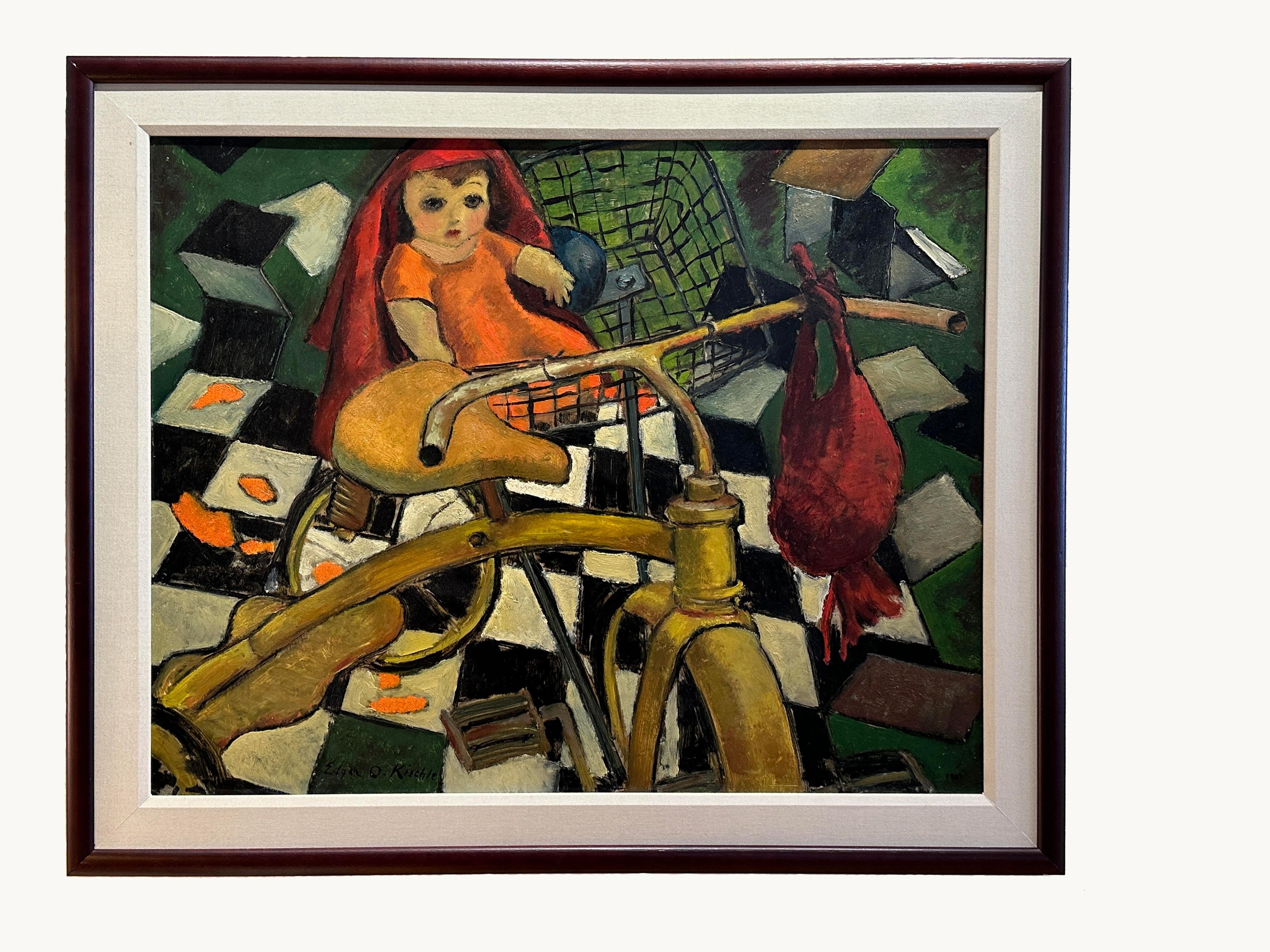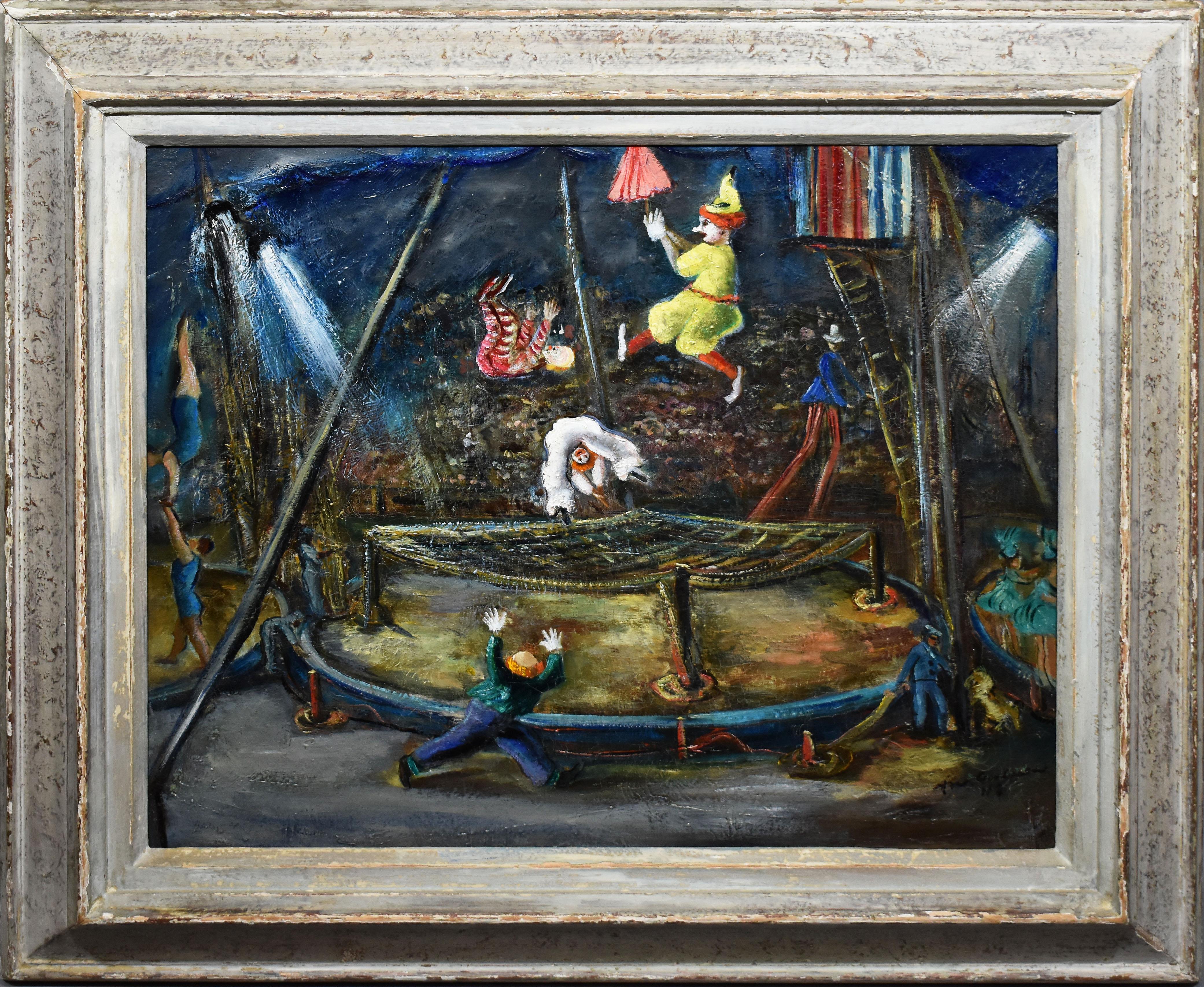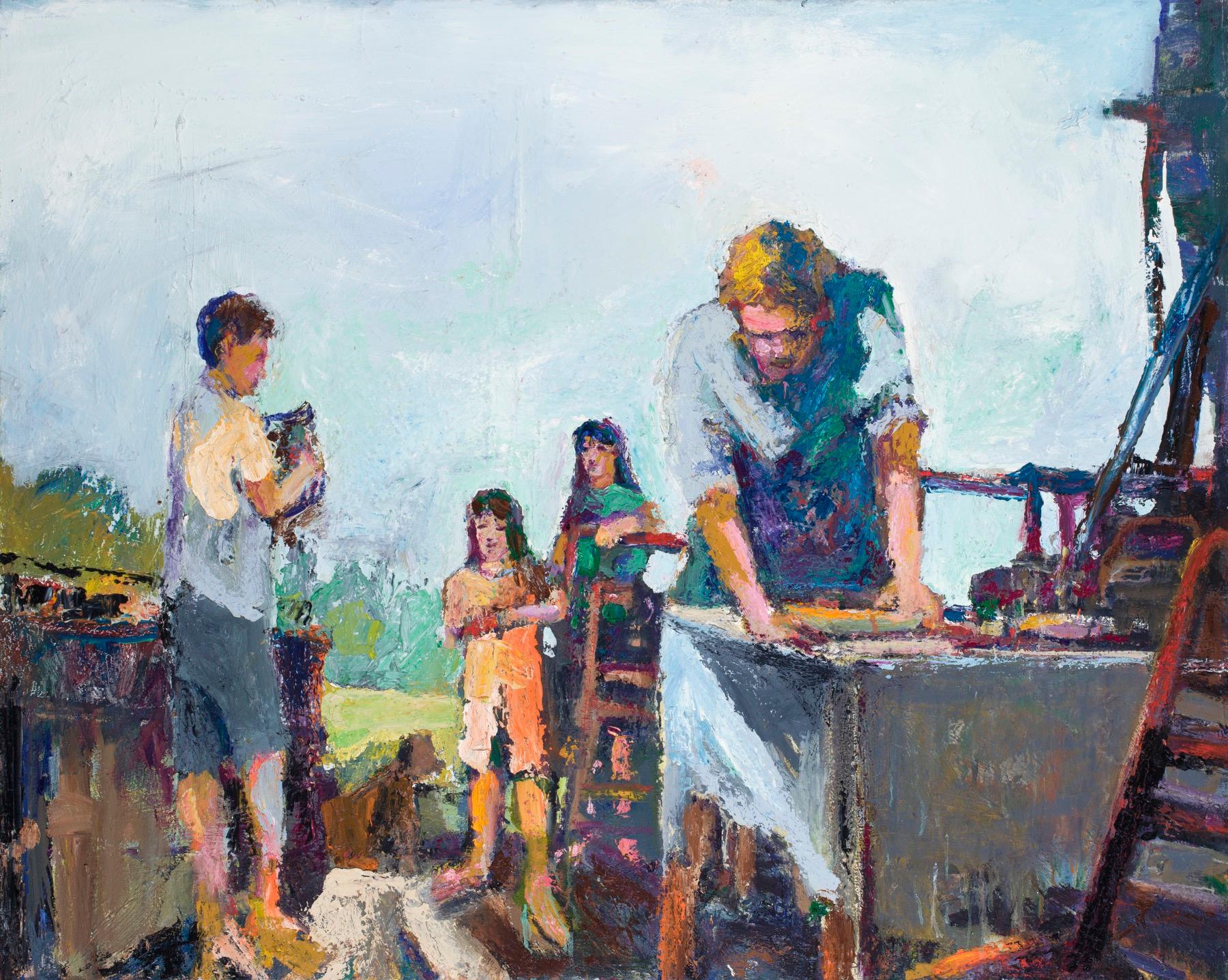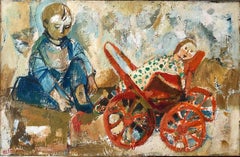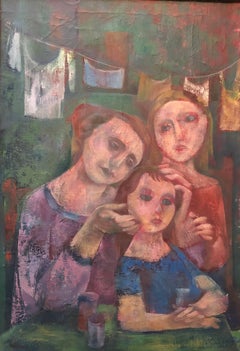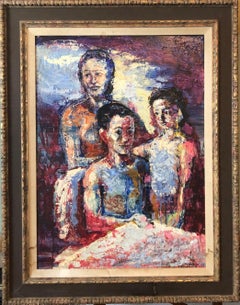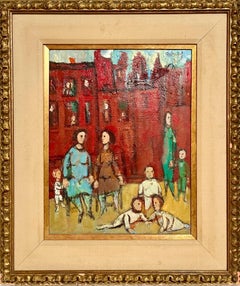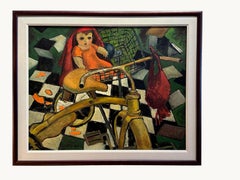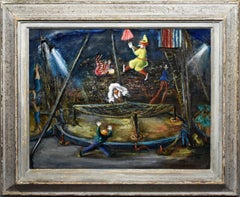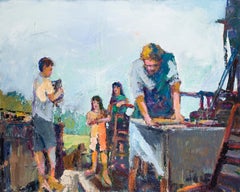Items Similar to Modernist Oil Painting Social Realist Kids and Cat in Red Wagon WPA Style
Want more images or videos?
Request additional images or videos from the seller
1 of 8
Paul ZimmermanModernist Oil Painting Social Realist Kids and Cat in Red Wagon WPA Stylec.1950s
c.1950s
$3,200
£2,481.19
€2,814.02
CA$4,587.06
A$4,988.53
CHF 2,628.07
MX$60,586.69
NOK 33,040.17
SEK 30,972.49
DKK 21,126.89
About the Item
Oil on artist's board, 20th century, signed Paul Zimmerman Reminiscent of the Mid Century Social Realist and WPA works of Ben Shahn this captures a group of tenement children of mixed races, African American, etc. all playing together in a wagon with their cat.
Paul Zimmerman, N.A. (1921-2007). Paul W. Zimmerman was an internationally known artist and professor emeritus of the Hartford Art School. Born April 29, 1921, in Toledo, Ohio, the son of Robert Frazee and Ethel Pearl (Cramer) Zimmerman, Zimmerman passed away December 15, 2007 in Hartford, Connecticut.
Always a great admirer of Cezanne, Zimmerman was particularly drawn to the French painter's innovations regarding space and the fracturing of the traditional picture plane.
In 1947, Henrik M. Mayer, Director of the Hartford Art School at the time, invited Zimmerman to join the faculty. What began as a two-year agreement became a 40-year career. He remained true to his personal artistic vision throughout his long distinguished career and continued to work in his studio, remain engaged in the artistic community and teach part-time at the West Hartford Art League, West Hartford, CT throughout his retirement.
A prolific landscape painter, Zimmerman's oils and watercolors are found in numerous museum, corporate and private collections, including the Connecticut Academy of Fine Arts; the Springfield Museum of Fine Arts; the Pennsylvania Academy of Fine Arts; the Wadsworth Atheneum; The Slater Museum; the University of Notre Dame; Lehigh University; First New Haven National Bank and United Technologies Corporation. He was also commissioned to design a series of murals for Chase Manhattan Bank in New York. Zimmerman is listed in Davenport's, A Grand Tradition: Art and Artists of the Hoosier Salon, and Who was Who in American Art. Born in Toledo Ohio in 1921, he studied at the John Herron Art School and earned his BFA degree in 1946. His work has been represented by galleries in New York, Maine, Connecticut, Ohio, etc. He was an associate member of the National Academy of Design in 1959 and became a full member of the National Academy of Design in 1972. Zimmerman was also a member of the Connecticut Academy of Fine Arts and the Connecticut Water Color Society. His work was exhibited at the famed Hoosier Salon Indiana in 1944, 1948, 1950, 1952, 1955. Also his work was exhibited at the Corcoran Gallery, John Herron Art Musuem Indianapolis, University of Illinois, Pennsylvania Academy of Fine Arts annuals, Connecticut Water Color Society, the National Academy of Design, and the New Britain Museum of American Art. He won many awards such as: The Hallgarten Prize (1954); The Wallace Truman Prize (1956); The Salmagundi Club Prize from the National Academy (1962); Second Prize Butler Art Institute (1958); Members Prize, Boston Arts Festival (1964); The Patrick B. McGinnis Award, Berkshire Arts Festival (1961); Second Prize at Chautauqua (1955); The Howard Penrose Award, Connecticut Academy (1959); Third Prize, Kearney Memorial Regional Exhibition Milwaukee WI (1964); The Gertrude Melcher Springer Prize at the Indiana Exhibition (1959); First Prize, Connecticut Watercolor Society, the J. I. Holcomb Prize from the Herron Art Musuem (1955), and many others. Throughout his extensive career, Paul received well over 86 awards in both regional and national exhibitions. He was also elected a member of the National Academy of Design. His work can be seen in numerous museums, including the Slater Memorial Museum, Springfield Museum of Fine Arts, Pennsylvania Academy of Fine Arts, Wadsworth Atheneum Museum of Art, University of Notre Dame, Lehigh University and Houston Museum of Fine Art, as well as in many corporate and private collections.
- Creator:Paul Zimmerman (American)
- Creation Year:c.1950s
- Dimensions:Height: 40 in (101.6 cm)Width: 28 in (71.12 cm)
- Medium:
- Movement & Style:
- Period:
- Condition:minor wear. wear, minor loss around edges where it was under frame. a couple minor scuffs, chips. unframed.
- Gallery Location:Surfside, FL
- Reference Number:1stDibs: LU38213119192
About the Seller
4.9
Platinum Seller
Premium sellers with a 4.7+ rating and 24-hour response times
Established in 1995
1stDibs seller since 2014
1,824 sales on 1stDibs
Typical response time: 1 hour
- ShippingRetrieving quote...Shipping from: Surfside, FL
- Return Policy
Authenticity Guarantee
In the unlikely event there’s an issue with an item’s authenticity, contact us within 1 year for a full refund. DetailsMoney-Back Guarantee
If your item is not as described, is damaged in transit, or does not arrive, contact us within 7 days for a full refund. Details24-Hour Cancellation
You have a 24-hour grace period in which to reconsider your purchase, with no questions asked.Vetted Professional Sellers
Our world-class sellers must adhere to strict standards for service and quality, maintaining the integrity of our listings.Price-Match Guarantee
If you find that a seller listed the same item for a lower price elsewhere, we’ll match it.Trusted Global Delivery
Our best-in-class carrier network provides specialized shipping options worldwide, including custom delivery.More From This Seller
View AllIsraeli Oil Painting Ruth Schloss Child, Doll, Wagon, Kibbutz Social Realist Art
By Ruth Schloss
Located in Surfside, FL
Large magnificent colorful Ruth Schloss oil painting of a child with a wagon with a doll or a baby in a carriage stroller.. Signed in Hebrew
size measures 31x43 with frame , 23x35.25 without the frame. (this is being sold unframed).
Ruth Schloss (22 November 1922 – 2013) was an Israeli painter and illustrator who mainly depicted neglected scenes such as Arabs, transition camps, children and women at eye-level as egalitarian, socialist view via social realism style painting and drawing.
Schloss became Israeli painting’s sensitive, conscious, remembering eye.
Ruth Schloss was born on 22 November 1922, in Nuremberg, Germany, to Ludwig and Dian Schloss, as the second of three daughters of bourgeois assimilationist Jewish family well-integrated into German culture. As the Nazis came into power in 1933, her family immigrated to Israel in 1937, and settled in Kfar Shmaryahu, then an agricultural settlement. Schloss studied at the Department of Schloss graphic design at "Bezalel" from 1938 to 1942 alongside Friedel Stern and Joseph Hirsch. She was a realistic painter who focused on disadvantaged people in the society and social matters as an egalitarian. Her realism was thus an “inevitable realism,” motivated by an inner necessity: the need to observe reality as it is.
Her painting repeatedly addressed the door pulled from its frame, employing drawing’s unique ability to stop time and prolong the image’s persistence in the retina, she repeatedly committed to paper - in a matter-of-fact, non-evasive manner devoid of mystery – man’s tendency to generate chaos, suffering and pain.
Throughout her life, Schloss remained minimalist. Painting about human fate was the main subject of her artworks. Her natural inclination was to describe the darker aspect of human existence.
1930s
The Schloss household was characterized by open, liberal spirit, in keeping with the parents’ progressive views. It deeply influenced Ruth’s mental development, as she learned to tie culture and art with sensitivity towards the weak and underprivileged.
In Jerusalem, she joined a commune of Hashomer Hatzair in which she shaped her socialist views, which she maintained throughout her long career.
1940s
In this period she mainly depicted landscapes of kibbutz and wretched women living hard life, children in huger, older people, refugees. After completing her art studies, Schloss joined a training group at Kibbutz Merhavia in 1942, and after two years moved to Karkur region, the nucleus established Kibutz Lehavot Habashan in the Upper Galilee. Through this time, she fell in love with the surroundings and drew landscapes. They are simple and direct with fresh, lucid lines. These paintings were selected as the main works of her first exhibition in 1949.
In early 1945, Schloss started to draw illustrations in the children’s magazine Mishmar Leyeladim, and designed the logo of Al Hamishmar, the paper’s new name in 1948. In 1948, upon the founding of Mapam (United Workers’ Party), she designed her party’s emblem, which became a well-known icon. She kept working as an illustrator for Mishmar Layeladim until 1949.
"Mor the Monkey" project yielded financial profits and this income was used for a study trip to Paris for two years. She was succesfull as illustrator however, she had inner conflicts of her identity as witnessed painter toward neglected class in Israeli society.
First Exhibition at Mikra-Studio Gallery, 1949
She presented forty drawings on paper in her first solo exhibition, representing a selection of the themes of kibbutz landscape, its lifestyle. Schloss confidently proposed her direction through simplicity without using colors in her drawings.
1950s
Between 1949 and 1951, she studied at the Académie de la Grande Chaumière in Paris.
She began working in oils, with which she continued throughout the 1960s.
The exhibition “Back from Paris” opened in November 1951 at Mikra-Studio Gallery .
In 1951 she married Benjamin Cohen, who served as chairman of the national leadership of Hashomer Hatzair Workers Party in Tel Aviv. He was a theoretician and a man of principle, highly esteemed by its leaders who became a professor of history at Tel Aviv University. In 1953, following the Mordechai Oren affair and the publication of Moshe Sneh 's followers from Kibbutz Artzi, she and her husband left the kibbutz and moved to the agricultural farm, Kfar Shmaryahu, where she lived until her death.
At a certain point in Israeli history, segments of the socialist movement felt that Israel should become part of the Communist bloc, rather than seek the support of the western world. Because the Schloss couple support of Moshe Sneh’s left-wing party, they had to leave the kibbutz.
She loved to depict ordinary women as figurative on her painting without hiding or making up anything. The poet Natan Zach wrote about her works in 1955: “Her motto remains that which has been all these years: life as it is, without bluffing."
Schloss’s “Pietà” (1953) became a universal cry expressing the pain of mothers on either side of the divide. In the late 1950s, she was the mother of two daughters. When she drew her daughters, unlike the universal babies she depicted, naked and with clenched fists, the painting of her children employed babyish sweetness to the full in a quiet, peaceful and heart-stirring filling rather than urgency. She also painted children in the transition camp and Jaffa in the 1950s and 1960s.
1960s-1980s – The period of Studio in Jaffa
Schloss painted at a studio in Jaffa from 1962 till 1983. In this time, she turned her interest to people around her more than kibbutz – the children, mothers, and poor workers, the alleys and houses. She opened the space to the street and its dwellings, built interactions around it, and was nurtured by the presence of the outside in her work.
1960s Schloss familiarized to an Arab woman, Nabava, lived in poor. Schloss returned to painting images of old people later, and she called her painting figurative elderly people in the old age homes “waiting”.
In the late 1960s, Ruth discovered acrylic paint and never turn back to oil painting.
In 1965 Schloss devoted a series “Area 9 (1965)”, dedicated to the demolition of Israeli-Arab houses and the expropriation of the land, and carried a definite socio-political messages. The series was exhibited at Beit Zvi, Ramat Gan, in 1966. She was the only artist who addressed the result of the Six-Day War immediately afterward. In 1968, Schloss and Gansser-Markus presented “Drawing of War” in Zurich gallery. She expressed the war as an ultimate expression of destruction and ruin, regardless of victors and vanquished.
1970s In late 1970s Schloss began printing the selected photograph directly on the canvas, posterior reworking it in acrylic. She decided to print her work at Har-El Printers in Jaffa, and these became the surface of her painting. This technique was mainly adopted in two large series: Anne Frank (1979-1980) and Borders (1982). Through this technique she placed the figure of elder Frank next to that of the famous young Frank, and released it at the exhibition at Bet Ariela Cultural Center, Tel Aviv, in 1981. The series touched upon the Nazi Holocaust.
1980s The Lebanon War raised the question of “The Good Fence” and the effect of the war. She dedicated a large series Boarders, one of the most powerful image linked to the series is the figure of Yemenite woman raising her hand. She was the first to raise the Black Panthers demonstration to the level of a social icon. In the 1980s and again in 2000, the Intifada uprisings also led Schloss to the easel to render a good number of representational and symbolic works that in their way denounced Israel's political and military actions.
1990s – 2000s Ruth Schloss never had an exhibition in a major Israeli museum. Her works were presented in private galleries and small museums. The main museums, the Tel Aviv Museum of Art and the Israel Museum, included her works only in group exhibitions, and only in 1991 was her retrospective exhibited at the Herzliya Museum.
In the 2000s, Schloss’s metaphors turned into animal kingdom and Bedouins in the south. A huge rhinoceros, birds of prey, and other "bad animals," as Cohen Evron, daughter of Ruth, calls them and "I connected this to the Nazis," said Schloss. Schloss' work after she didn't find human expression able to transmit the endless cruelty she saw in Israel's political mentality.
Schloss also continued to follow and collect documentary photographs of destructions of houses from the war, the Intifada, the sequence of her work about ruin from 1949 to 2005, was a cumulative testimony about the painful history of Israel and Palestine.
In 2006, a large retrospective exhibition of her work was presented at the Museum of Art in Ein Harod, curated by Tali Tamir.
Education
1938-41 Bezalel Art Academy, Jerusalem, with Mordecai Ardon
1946 painting course for Kibbutz Artzi artists with Yohanan Simon and Marcel Janco
1949-51 Académie de la Grande Chaumière, Paris
Awards and recognition
1965 Silver Medal, International exhibition in Leipzig, Germany
1977 Artist-in-Residence, The Cité Internationale Universitaire de Paris
Selected solo exhibitions
2004 “Micha...
Category
Mid-20th Century Realist Figurative Paintings
Materials
Canvas, Oil
New York City Tenement Family Modernist WPA Era Oil Painting Wolins
By Joseph Wolins
Located in Surfside, FL
Subject: American Family
Medium: Oil
Surface: Canvas
Country: United States
In this painting, Joseph Wolins uses vibrant and complimentary colors and broken brushwork.
Joseph Wo...
Category
20th Century American Modern Figurative Paintings
Materials
Canvas, Oil
Family Portrait, Large Surrealist Oil Painting Mother, Children, Neo Surrealism
Located in Surfside, FL
Hank Laventhol (1927–2001) was an American painter and master print maker. He worked in painting, graphics, sculpture and photography. Associated with ...
Category
1950s Surrealist Figurative Paintings
Materials
Oil, Board
Mid Century Mothers, Children Oil Painting Frank Kleinholz WPA Era NYC Tenements
By Frank Kleinholz
Located in Surfside, FL
Frank Kleinholz (Brooklyn, 1901 - 1987)
Mothers with children oil on canvas painting
Frame: 27 X 23
Image: 17.75 X 13.75
Born in Brooklyn, New York, Frank Kleinholz was a painter b...
Category
20th Century Abstract Figurative Paintings
Materials
Canvas, Oil
Large Modernist Oil Painting 1940s, Judaica Hasidic Shtetl Wagon Driver WPA Era
By Emanuel Glicenstein Romano
Located in Surfside, FL
Genre: Modern
Subject: Landscape with figure of horse, driver and wagon
Medium: Oil
Surface: wood Board
Hand signed lower middle E.Romano
EMANUEL ROMANO
Rome, Italy, b. 1897, d. 1984
Emanuel Glicen Romano was born in Rome, September 23, 1897.
His father Henryk Glicenstein was a sculptor and was living in Rome with his wife Helena (born Hirszenberg) when Emanuel was born. His father obtained Italian citizenship and adopted the name Enrico. Emanuel was brought up in Italy, Switzerland, Germany, England and Poland.
In 1926 Emanuel Glicenstein Romano and his father sailed for New York. They briefly visited Chicago. Romano's sister, Beatrice, and mother only joined them in New York years later.
Romano changed his name on his arrival to America and some have erroneously speculated that this was to avoid antisemitic discrimination. In truth, as the son of a highly-regarded artist, Romano changed his name to ensure that any success or recognition he would later attain, would be the result of nothing other than his own merit as an artist, and not on account of his father's fame.
In 1936 Romano was worked for the WPA Federal Art Project creating murals. ( there were many jewish artists active with in the WPA period. notably Chaim Gross, Ben Shahn, Isaac and Moses Soyer, Abraham Rattner and many others. During and immediately after World War II, Romano created a series of allegorical works depicting graphic holocaust images that were held closely by the family until after his passing. One of these works is now on permanent display in the Florida Holocaust Museum in St. Petersburg Florida.
Emanuel's father died in 1942 in a car accident before they could realize their shared dream of visiting Israel.
In 1944 Romano, having completed his degree at the Pennsylvania Academy of Fine Arts and the Art Institute of Chicago, began teaching at the City College of New York.
Romano moved to Safed, Israel in 1953 and established an art museum in his father's memory, the Glicenstein Museum.
COLLECTIONS
Indianapolis Museum of Art
Metropolitan Museum of Art
Boston Fine Arts Museum
Fogg Museum
Musée Nacional de France
Recently his work has been added to the Florida Holocaust Museum collection. His notable works include his holocaust themed allegorical paintings as well as portraits of Marianne Moore, his father and William Carlos Williams...
Category
1930s American Modern Figurative Paintings
Materials
Oil, Board
Simka Simkhovitch WPA Artist Oil Painting Family Mother, Kids American Modernist
By Simka Simkhovitch
Located in Surfside, FL
Simka Simkhovitch (Russian/American 1893 - 1949)
This came with a small grouping from the artist's family, some were hand signed some were not.
These were studies for larger paintin...
Category
1930s American Modern Figurative Paintings
Materials
Oil, Board
You May Also Like
Children Playing, Oil Painting by Marshall Goodman
By Marshall Goodman
Located in Long Island City, NY
Artist: Marshall Goodman, American (1916 - 2003)
Title: Children Playing
Year: circa 1960
Medium: Oil on Canvas, signed l.r.
Size: 30 x 25 in. (76.2 x 63.5 cm)
Category
1960s American Modern Figurative Paintings
Materials
Cotton Canvas, Oil
" Tricycle and Doll" Oil on Canvas by Edgar Kiechle
Located in Pasadena, CA
This figurative painting by Edgard Kiechle presents the scenario of a doll who is very surprised to have been abandoned into the basket of her mom's tricycle.
An interesting factor is the pictorial use of angles. The point of view, a little above the stage, probably that of an adult, offers particular perspectives. This approach adds depth to this painting with distinctive compositional appeal.
In contrast to the scene's disorder, a black-and-white tiled floor with a geometric design serves as an antithesis. The careful symmetry of the tiles competing with the surrounding disarray sparks a dialogue about the human need for organization and balance.
In composition, absence is a living element. The exclusion of a physical human figure amplifies the feeling of emptiness, creating a human presence perceived imaginatively.
Edgar O. Kiechle was born in 1911. He was a film illustrator and a painter.
Edgar studied landscape painting with Jean Mannheim and architecture and became an excellent watercolorist. After studying at the Otis Art Institute in Los Angeles, he interned with leading architects and designers. He worked at most major studios, but his career as an illustrator saw him primarily at the Universal Studio Art department.
In 1933, Edgar joined Lwerks as a background artist and worked on many films produced by Animated Picture Corporation through 1935.
In the summer of 1941, Edgar Kiechle...
Category
Mid-20th Century Figurative Paintings
Materials
Oil, Canvas
$398 Sale Price
75% Off
Antique American Ashcan School Modernist Circus Scene Signed PA Oil Painting
Located in Buffalo, NY
Antique American school modernist circus scene by Ann Taube Goodman (Born 1905). Oil on canvas, circa 1925.
Signed. Displayed in a modernist fra...
Category
1910s Modern Landscape Paintings
Materials
Canvas, Oil
The Apprentice - figurative family and children - oil on canvas in bold color
By William Rushton
Located in Burlingame, CA
Friends and onlookers gather under a blue-grey sky as they watch and learn together from an apprentice, in this idyllic scene of people and their day on the coast plays out. The wa...
Category
21st Century and Contemporary Contemporary Figurative Paintings
Materials
Oil, Board
Mid-Century Children's Party Scene . Red and Orange, Native American
Located in Miami, FL
Broad areas of bold, flat red, magenta, and pink characterize this mid-century painting by Barbara Warren Ebersole ( Barbara Tate Ebersole ). It depicts a block party festooned with balloons and a street organ grinder with a smartly dressed performing monkey. The overall look of a lot mid-century art inspires many of today's most celebrated contemporary artists. Signed and dated upper left. Oil on Masonite. Barbara Warren Ebersole was a painter and an author. She may have been of Native American...
Category
1950s American Modern Figurative Paintings
Materials
Masonite, Oil
Child with Doll and Buggy, Impressionist Oil Painting by Carlos Irizarry
By Carlos Irizarry
Located in Long Island City, NY
Artist: Carlos Irizarry
Title: Child with Doll and Buggy
Year: circa 1965
Medium: Oil on Canvas, signed l.r.
Size: 30 in. x 24 in. (76.2 cm x 60.96 cm)...
Category
1960s Expressionist Figurative Paintings
Materials
Oil, Canvas
More Ways To Browse
Vintage Wagoneer
Cat Mid Century Art
Cat Realist Paintings
Mid Century Kids
Modernist Cat
Chautauqua Vintage
Wpa Styled Oil Paintings
Old Master Christ
Shadow Puppets
Social Realism Social Realism Art 1930s And 1940s
Trucks Painting
Vintage Brunette
Hyperrealism Art
Lip Paintings
Michael Golden
Nike Art
Oil Painting Conversation
Oil Paintings Dinner
